Financial Decision Making Report: Analysis of SKANSKA PLC Finances
VerifiedAdded on 2022/12/27
|11
|3608
|24
Report
AI Summary
This report provides a detailed financial analysis of SKANSKA PLC, examining the critical aspects of financial decision-making. It begins with an introduction highlighting the significance of financial analysis in today's competitive market. The report then delves into the roles, functions, and duties of accounting and finance departments within SKANSKA PLC. The report further analyzes key financial ratios, including Return on Capital Employed (ROCE) and Net Profit Margin, interpreting their implications for the company's financial health and performance. The analysis covers data from 2018 and 2019, offering insights into trends and areas for improvement, as well as the factors affecting them. The report concludes with a summary of findings and recommendations based on the financial data and analysis. The report emphasizes the importance of accurate financial management for business success.

Financial decision
making
making
Paraphrase This Document
Need a fresh take? Get an instant paraphrase of this document with our AI Paraphraser
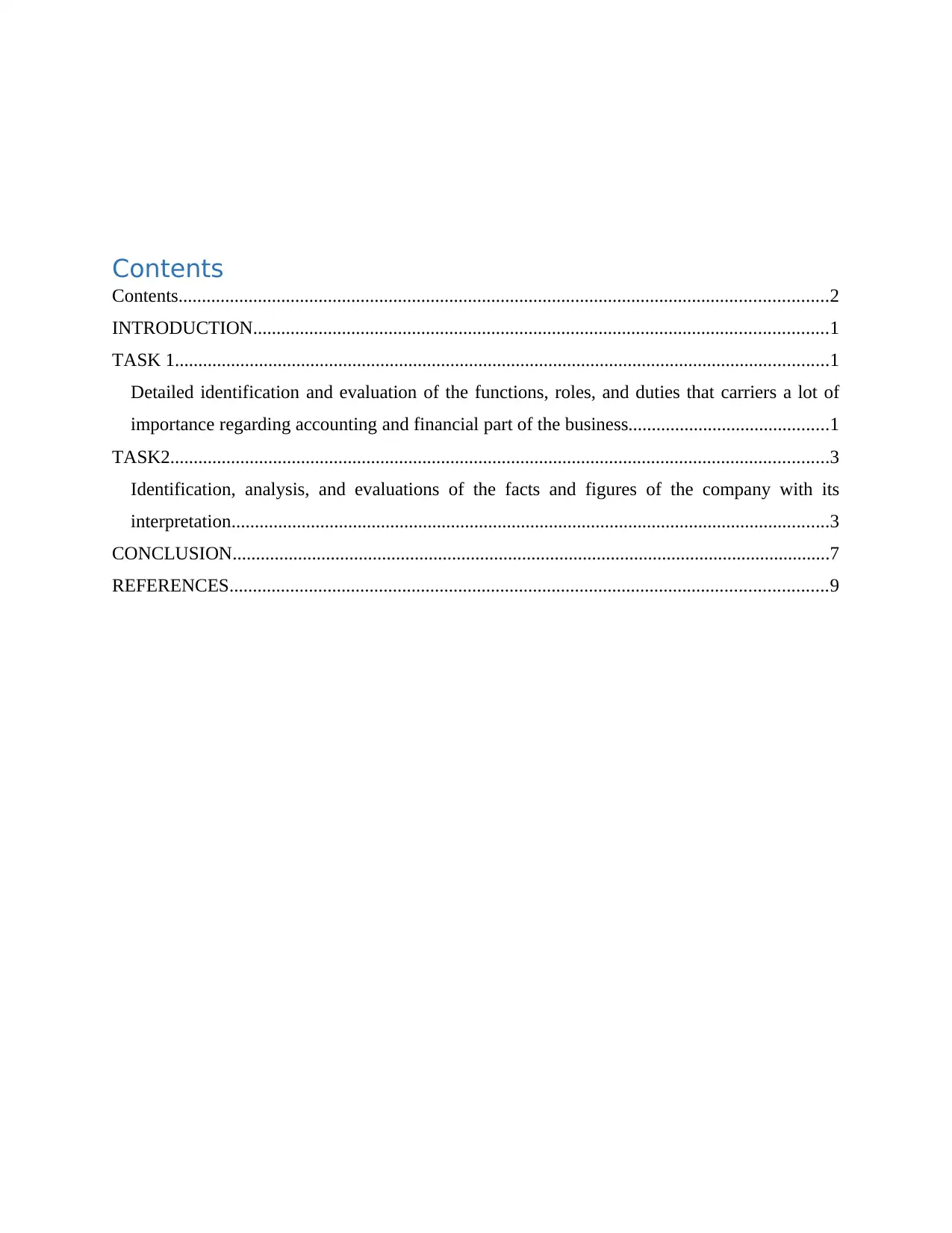
Contents
Contents...........................................................................................................................................2
INTRODUCTION...........................................................................................................................1
TASK 1............................................................................................................................................1
Detailed identification and evaluation of the functions, roles, and duties that carriers a lot of
importance regarding accounting and financial part of the business...........................................1
TASK2.............................................................................................................................................3
Identification, analysis, and evaluations of the facts and figures of the company with its
interpretation................................................................................................................................3
CONCLUSION................................................................................................................................7
REFERENCES................................................................................................................................9
Contents...........................................................................................................................................2
INTRODUCTION...........................................................................................................................1
TASK 1............................................................................................................................................1
Detailed identification and evaluation of the functions, roles, and duties that carriers a lot of
importance regarding accounting and financial part of the business...........................................1
TASK2.............................................................................................................................................3
Identification, analysis, and evaluations of the facts and figures of the company with its
interpretation................................................................................................................................3
CONCLUSION................................................................................................................................7
REFERENCES................................................................................................................................9
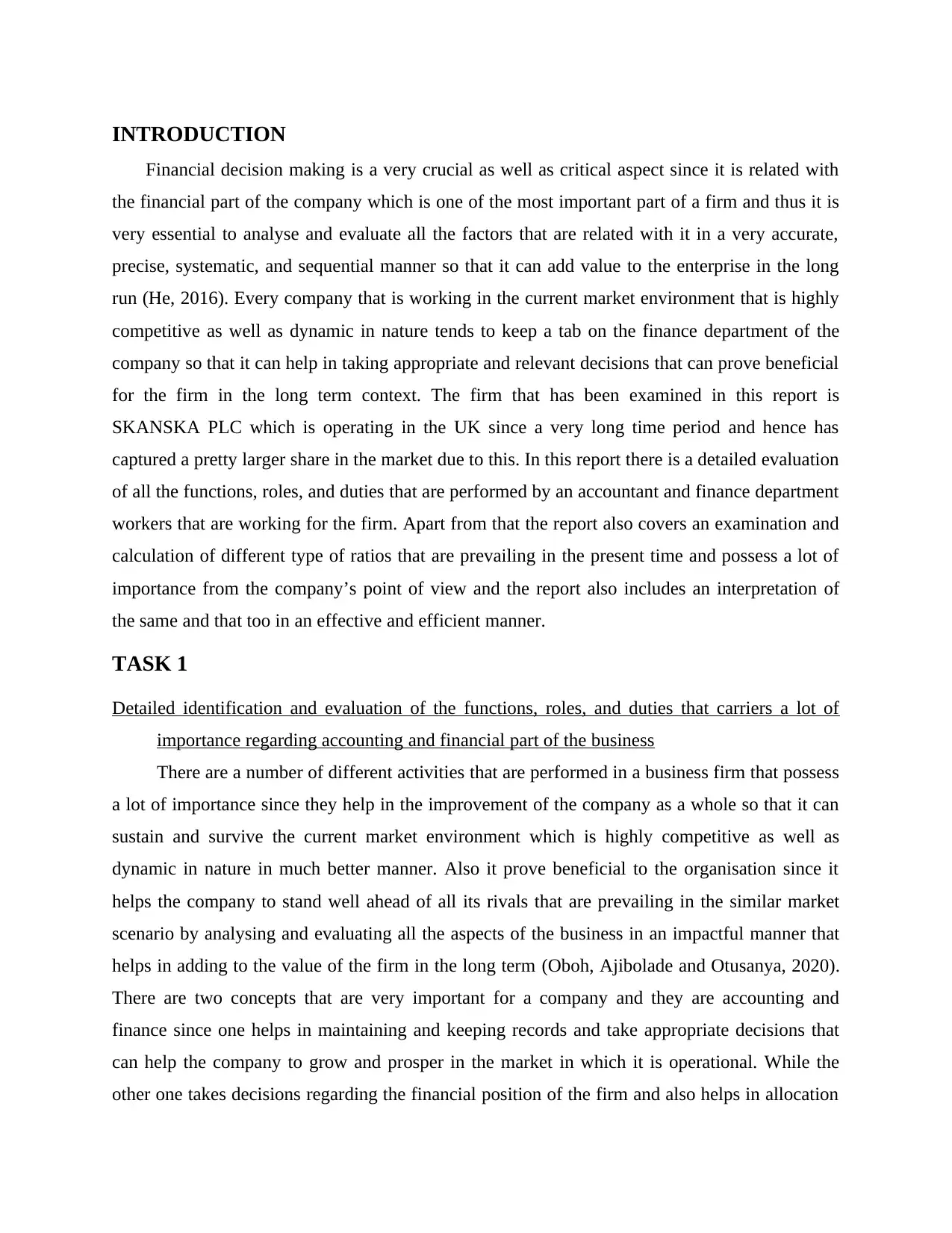
INTRODUCTION
Financial decision making is a very crucial as well as critical aspect since it is related with
the financial part of the company which is one of the most important part of a firm and thus it is
very essential to analyse and evaluate all the factors that are related with it in a very accurate,
precise, systematic, and sequential manner so that it can add value to the enterprise in the long
run (He, 2016). Every company that is working in the current market environment that is highly
competitive as well as dynamic in nature tends to keep a tab on the finance department of the
company so that it can help in taking appropriate and relevant decisions that can prove beneficial
for the firm in the long term context. The firm that has been examined in this report is
SKANSKA PLC which is operating in the UK since a very long time period and hence has
captured a pretty larger share in the market due to this. In this report there is a detailed evaluation
of all the functions, roles, and duties that are performed by an accountant and finance department
workers that are working for the firm. Apart from that the report also covers an examination and
calculation of different type of ratios that are prevailing in the present time and possess a lot of
importance from the company’s point of view and the report also includes an interpretation of
the same and that too in an effective and efficient manner.
TASK 1
Detailed identification and evaluation of the functions, roles, and duties that carriers a lot of
importance regarding accounting and financial part of the business
There are a number of different activities that are performed in a business firm that possess
a lot of importance since they help in the improvement of the company as a whole so that it can
sustain and survive the current market environment which is highly competitive as well as
dynamic in nature in much better manner. Also it prove beneficial to the organisation since it
helps the company to stand well ahead of all its rivals that are prevailing in the similar market
scenario by analysing and evaluating all the aspects of the business in an impactful manner that
helps in adding to the value of the firm in the long term (Oboh, Ajibolade and Otusanya, 2020).
There are two concepts that are very important for a company and they are accounting and
finance since one helps in maintaining and keeping records and take appropriate decisions that
can help the company to grow and prosper in the market in which it is operational. While the
other one takes decisions regarding the financial position of the firm and also helps in allocation
Financial decision making is a very crucial as well as critical aspect since it is related with
the financial part of the company which is one of the most important part of a firm and thus it is
very essential to analyse and evaluate all the factors that are related with it in a very accurate,
precise, systematic, and sequential manner so that it can add value to the enterprise in the long
run (He, 2016). Every company that is working in the current market environment that is highly
competitive as well as dynamic in nature tends to keep a tab on the finance department of the
company so that it can help in taking appropriate and relevant decisions that can prove beneficial
for the firm in the long term context. The firm that has been examined in this report is
SKANSKA PLC which is operating in the UK since a very long time period and hence has
captured a pretty larger share in the market due to this. In this report there is a detailed evaluation
of all the functions, roles, and duties that are performed by an accountant and finance department
workers that are working for the firm. Apart from that the report also covers an examination and
calculation of different type of ratios that are prevailing in the present time and possess a lot of
importance from the company’s point of view and the report also includes an interpretation of
the same and that too in an effective and efficient manner.
TASK 1
Detailed identification and evaluation of the functions, roles, and duties that carriers a lot of
importance regarding accounting and financial part of the business
There are a number of different activities that are performed in a business firm that possess
a lot of importance since they help in the improvement of the company as a whole so that it can
sustain and survive the current market environment which is highly competitive as well as
dynamic in nature in much better manner. Also it prove beneficial to the organisation since it
helps the company to stand well ahead of all its rivals that are prevailing in the similar market
scenario by analysing and evaluating all the aspects of the business in an impactful manner that
helps in adding to the value of the firm in the long term (Oboh, Ajibolade and Otusanya, 2020).
There are two concepts that are very important for a company and they are accounting and
finance since one helps in maintaining and keeping records and take appropriate decisions that
can help the company to grow and prosper in the market in which it is operational. While the
other one takes decisions regarding the financial position of the firm and also helps in allocation
⊘ This is a preview!⊘
Do you want full access?
Subscribe today to unlock all pages.

Trusted by 1+ million students worldwide
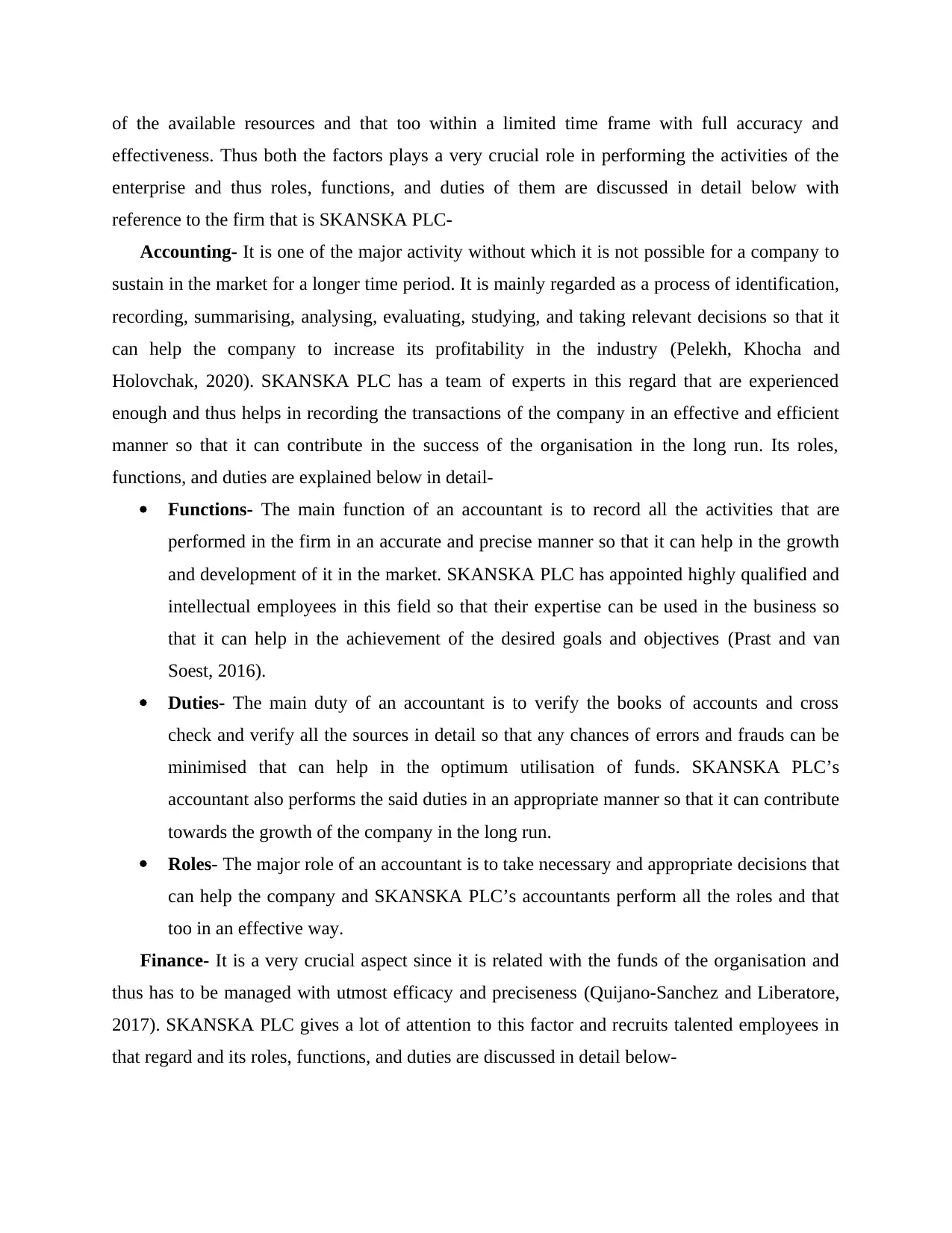
of the available resources and that too within a limited time frame with full accuracy and
effectiveness. Thus both the factors plays a very crucial role in performing the activities of the
enterprise and thus roles, functions, and duties of them are discussed in detail below with
reference to the firm that is SKANSKA PLC-
Accounting- It is one of the major activity without which it is not possible for a company to
sustain in the market for a longer time period. It is mainly regarded as a process of identification,
recording, summarising, analysing, evaluating, studying, and taking relevant decisions so that it
can help the company to increase its profitability in the industry (Pelekh, Khocha and
Holovchak, 2020). SKANSKA PLC has a team of experts in this regard that are experienced
enough and thus helps in recording the transactions of the company in an effective and efficient
manner so that it can contribute in the success of the organisation in the long run. Its roles,
functions, and duties are explained below in detail-
Functions- The main function of an accountant is to record all the activities that are
performed in the firm in an accurate and precise manner so that it can help in the growth
and development of it in the market. SKANSKA PLC has appointed highly qualified and
intellectual employees in this field so that their expertise can be used in the business so
that it can help in the achievement of the desired goals and objectives (Prast and van
Soest, 2016).
Duties- The main duty of an accountant is to verify the books of accounts and cross
check and verify all the sources in detail so that any chances of errors and frauds can be
minimised that can help in the optimum utilisation of funds. SKANSKA PLC’s
accountant also performs the said duties in an appropriate manner so that it can contribute
towards the growth of the company in the long run.
Roles- The major role of an accountant is to take necessary and appropriate decisions that
can help the company and SKANSKA PLC’s accountants perform all the roles and that
too in an effective way.
Finance- It is a very crucial aspect since it is related with the funds of the organisation and
thus has to be managed with utmost efficacy and preciseness (Quijano-Sanchez and Liberatore,
2017). SKANSKA PLC gives a lot of attention to this factor and recruits talented employees in
that regard and its roles, functions, and duties are discussed in detail below-
effectiveness. Thus both the factors plays a very crucial role in performing the activities of the
enterprise and thus roles, functions, and duties of them are discussed in detail below with
reference to the firm that is SKANSKA PLC-
Accounting- It is one of the major activity without which it is not possible for a company to
sustain in the market for a longer time period. It is mainly regarded as a process of identification,
recording, summarising, analysing, evaluating, studying, and taking relevant decisions so that it
can help the company to increase its profitability in the industry (Pelekh, Khocha and
Holovchak, 2020). SKANSKA PLC has a team of experts in this regard that are experienced
enough and thus helps in recording the transactions of the company in an effective and efficient
manner so that it can contribute in the success of the organisation in the long run. Its roles,
functions, and duties are explained below in detail-
Functions- The main function of an accountant is to record all the activities that are
performed in the firm in an accurate and precise manner so that it can help in the growth
and development of it in the market. SKANSKA PLC has appointed highly qualified and
intellectual employees in this field so that their expertise can be used in the business so
that it can help in the achievement of the desired goals and objectives (Prast and van
Soest, 2016).
Duties- The main duty of an accountant is to verify the books of accounts and cross
check and verify all the sources in detail so that any chances of errors and frauds can be
minimised that can help in the optimum utilisation of funds. SKANSKA PLC’s
accountant also performs the said duties in an appropriate manner so that it can contribute
towards the growth of the company in the long run.
Roles- The major role of an accountant is to take necessary and appropriate decisions that
can help the company and SKANSKA PLC’s accountants perform all the roles and that
too in an effective way.
Finance- It is a very crucial aspect since it is related with the funds of the organisation and
thus has to be managed with utmost efficacy and preciseness (Quijano-Sanchez and Liberatore,
2017). SKANSKA PLC gives a lot of attention to this factor and recruits talented employees in
that regard and its roles, functions, and duties are discussed in detail below-
Paraphrase This Document
Need a fresh take? Get an instant paraphrase of this document with our AI Paraphraser
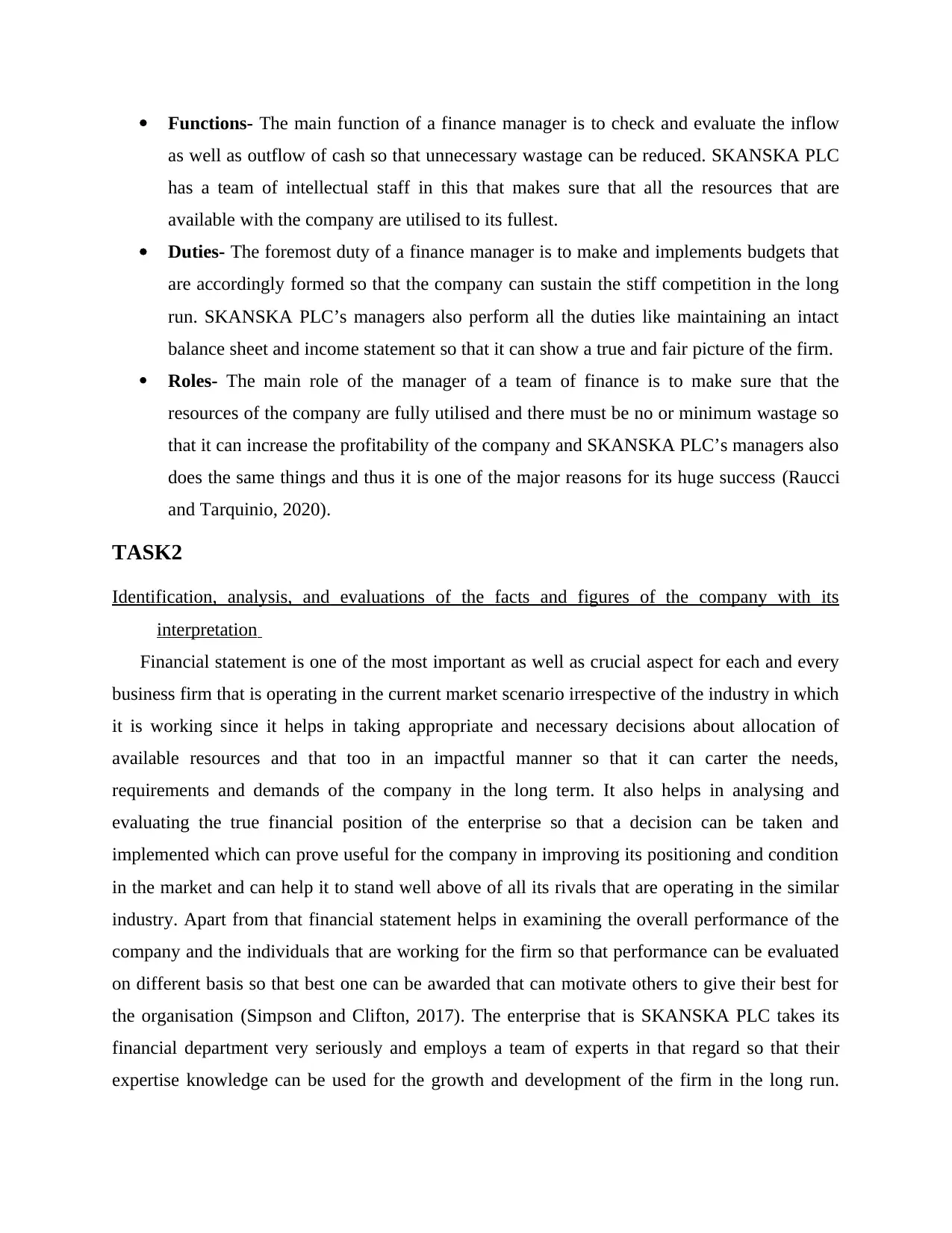
Functions- The main function of a finance manager is to check and evaluate the inflow
as well as outflow of cash so that unnecessary wastage can be reduced. SKANSKA PLC
has a team of intellectual staff in this that makes sure that all the resources that are
available with the company are utilised to its fullest.
Duties- The foremost duty of a finance manager is to make and implements budgets that
are accordingly formed so that the company can sustain the stiff competition in the long
run. SKANSKA PLC’s managers also perform all the duties like maintaining an intact
balance sheet and income statement so that it can show a true and fair picture of the firm.
Roles- The main role of the manager of a team of finance is to make sure that the
resources of the company are fully utilised and there must be no or minimum wastage so
that it can increase the profitability of the company and SKANSKA PLC’s managers also
does the same things and thus it is one of the major reasons for its huge success (Raucci
and Tarquinio, 2020).
TASK2
Identification, analysis, and evaluations of the facts and figures of the company with its
interpretation
Financial statement is one of the most important as well as crucial aspect for each and every
business firm that is operating in the current market scenario irrespective of the industry in which
it is working since it helps in taking appropriate and necessary decisions about allocation of
available resources and that too in an impactful manner so that it can carter the needs,
requirements and demands of the company in the long term. It also helps in analysing and
evaluating the true financial position of the enterprise so that a decision can be taken and
implemented which can prove useful for the company in improving its positioning and condition
in the market and can help it to stand well above of all its rivals that are operating in the similar
industry. Apart from that financial statement helps in examining the overall performance of the
company and the individuals that are working for the firm so that performance can be evaluated
on different basis so that best one can be awarded that can motivate others to give their best for
the organisation (Simpson and Clifton, 2017). The enterprise that is SKANSKA PLC takes its
financial department very seriously and employs a team of experts in that regard so that their
expertise knowledge can be used for the growth and development of the firm in the long run.
as well as outflow of cash so that unnecessary wastage can be reduced. SKANSKA PLC
has a team of intellectual staff in this that makes sure that all the resources that are
available with the company are utilised to its fullest.
Duties- The foremost duty of a finance manager is to make and implements budgets that
are accordingly formed so that the company can sustain the stiff competition in the long
run. SKANSKA PLC’s managers also perform all the duties like maintaining an intact
balance sheet and income statement so that it can show a true and fair picture of the firm.
Roles- The main role of the manager of a team of finance is to make sure that the
resources of the company are fully utilised and there must be no or minimum wastage so
that it can increase the profitability of the company and SKANSKA PLC’s managers also
does the same things and thus it is one of the major reasons for its huge success (Raucci
and Tarquinio, 2020).
TASK2
Identification, analysis, and evaluations of the facts and figures of the company with its
interpretation
Financial statement is one of the most important as well as crucial aspect for each and every
business firm that is operating in the current market scenario irrespective of the industry in which
it is working since it helps in taking appropriate and necessary decisions about allocation of
available resources and that too in an impactful manner so that it can carter the needs,
requirements and demands of the company in the long term. It also helps in analysing and
evaluating the true financial position of the enterprise so that a decision can be taken and
implemented which can prove useful for the company in improving its positioning and condition
in the market and can help it to stand well above of all its rivals that are operating in the similar
industry. Apart from that financial statement helps in examining the overall performance of the
company and the individuals that are working for the firm so that performance can be evaluated
on different basis so that best one can be awarded that can motivate others to give their best for
the organisation (Simpson and Clifton, 2017). The enterprise that is SKANSKA PLC takes its
financial department very seriously and employs a team of experts in that regard so that their
expertise knowledge can be used for the growth and development of the firm in the long run.
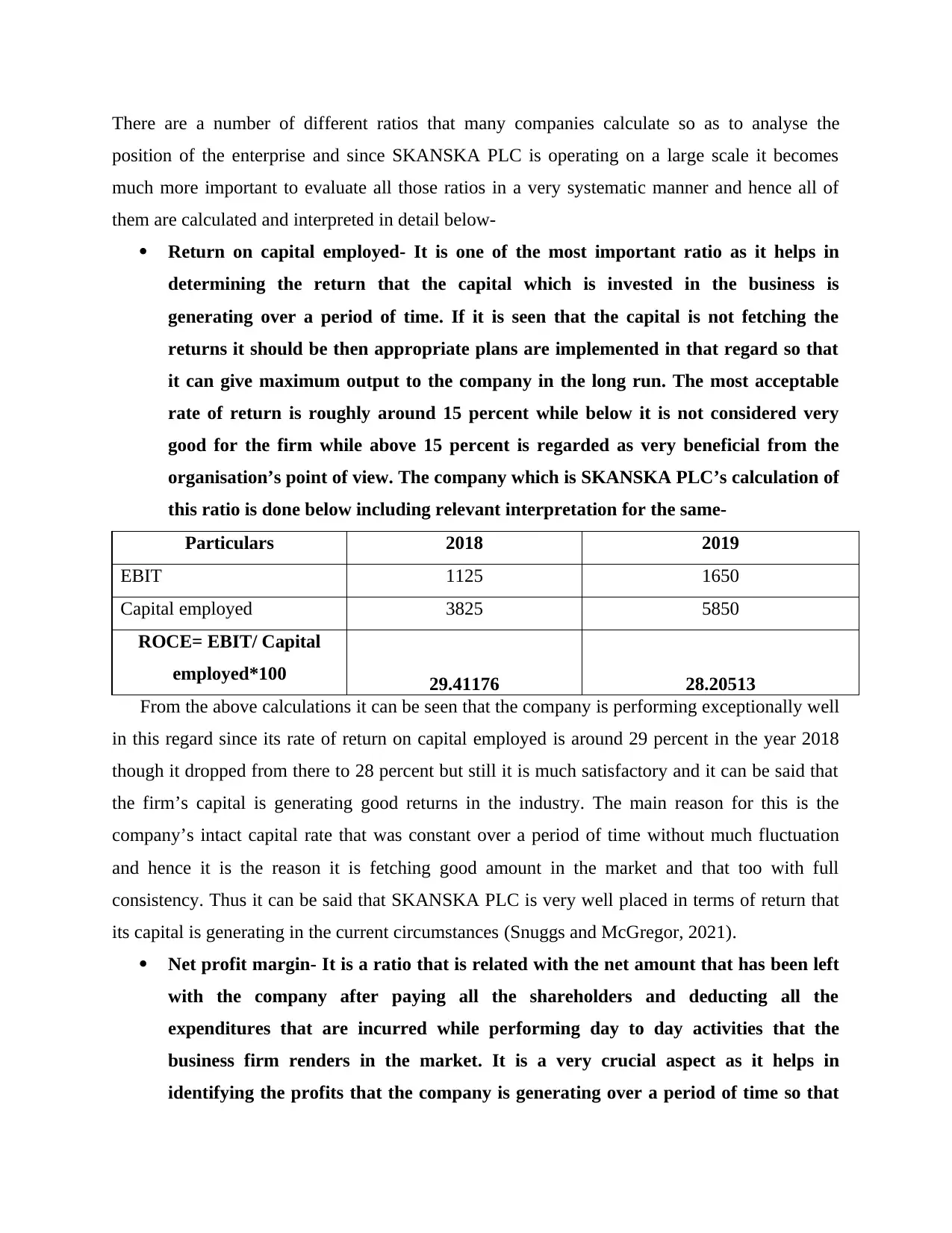
There are a number of different ratios that many companies calculate so as to analyse the
position of the enterprise and since SKANSKA PLC is operating on a large scale it becomes
much more important to evaluate all those ratios in a very systematic manner and hence all of
them are calculated and interpreted in detail below-
Return on capital employed- It is one of the most important ratio as it helps in
determining the return that the capital which is invested in the business is
generating over a period of time. If it is seen that the capital is not fetching the
returns it should be then appropriate plans are implemented in that regard so that
it can give maximum output to the company in the long run. The most acceptable
rate of return is roughly around 15 percent while below it is not considered very
good for the firm while above 15 percent is regarded as very beneficial from the
organisation’s point of view. The company which is SKANSKA PLC’s calculation of
this ratio is done below including relevant interpretation for the same-
Particulars 2018 2019
EBIT 1125 1650
Capital employed 3825 5850
ROCE= EBIT/ Capital
employed*100 29.41176 28.20513
From the above calculations it can be seen that the company is performing exceptionally well
in this regard since its rate of return on capital employed is around 29 percent in the year 2018
though it dropped from there to 28 percent but still it is much satisfactory and it can be said that
the firm’s capital is generating good returns in the industry. The main reason for this is the
company’s intact capital rate that was constant over a period of time without much fluctuation
and hence it is the reason it is fetching good amount in the market and that too with full
consistency. Thus it can be said that SKANSKA PLC is very well placed in terms of return that
its capital is generating in the current circumstances (Snuggs and McGregor, 2021).
Net profit margin- It is a ratio that is related with the net amount that has been left
with the company after paying all the shareholders and deducting all the
expenditures that are incurred while performing day to day activities that the
business firm renders in the market. It is a very crucial aspect as it helps in
identifying the profits that the company is generating over a period of time so that
position of the enterprise and since SKANSKA PLC is operating on a large scale it becomes
much more important to evaluate all those ratios in a very systematic manner and hence all of
them are calculated and interpreted in detail below-
Return on capital employed- It is one of the most important ratio as it helps in
determining the return that the capital which is invested in the business is
generating over a period of time. If it is seen that the capital is not fetching the
returns it should be then appropriate plans are implemented in that regard so that
it can give maximum output to the company in the long run. The most acceptable
rate of return is roughly around 15 percent while below it is not considered very
good for the firm while above 15 percent is regarded as very beneficial from the
organisation’s point of view. The company which is SKANSKA PLC’s calculation of
this ratio is done below including relevant interpretation for the same-
Particulars 2018 2019
EBIT 1125 1650
Capital employed 3825 5850
ROCE= EBIT/ Capital
employed*100 29.41176 28.20513
From the above calculations it can be seen that the company is performing exceptionally well
in this regard since its rate of return on capital employed is around 29 percent in the year 2018
though it dropped from there to 28 percent but still it is much satisfactory and it can be said that
the firm’s capital is generating good returns in the industry. The main reason for this is the
company’s intact capital rate that was constant over a period of time without much fluctuation
and hence it is the reason it is fetching good amount in the market and that too with full
consistency. Thus it can be said that SKANSKA PLC is very well placed in terms of return that
its capital is generating in the current circumstances (Snuggs and McGregor, 2021).
Net profit margin- It is a ratio that is related with the net amount that has been left
with the company after paying all the shareholders and deducting all the
expenditures that are incurred while performing day to day activities that the
business firm renders in the market. It is a very crucial aspect as it helps in
identifying the profits that the company is generating over a period of time so that
⊘ This is a preview!⊘
Do you want full access?
Subscribe today to unlock all pages.

Trusted by 1+ million students worldwide
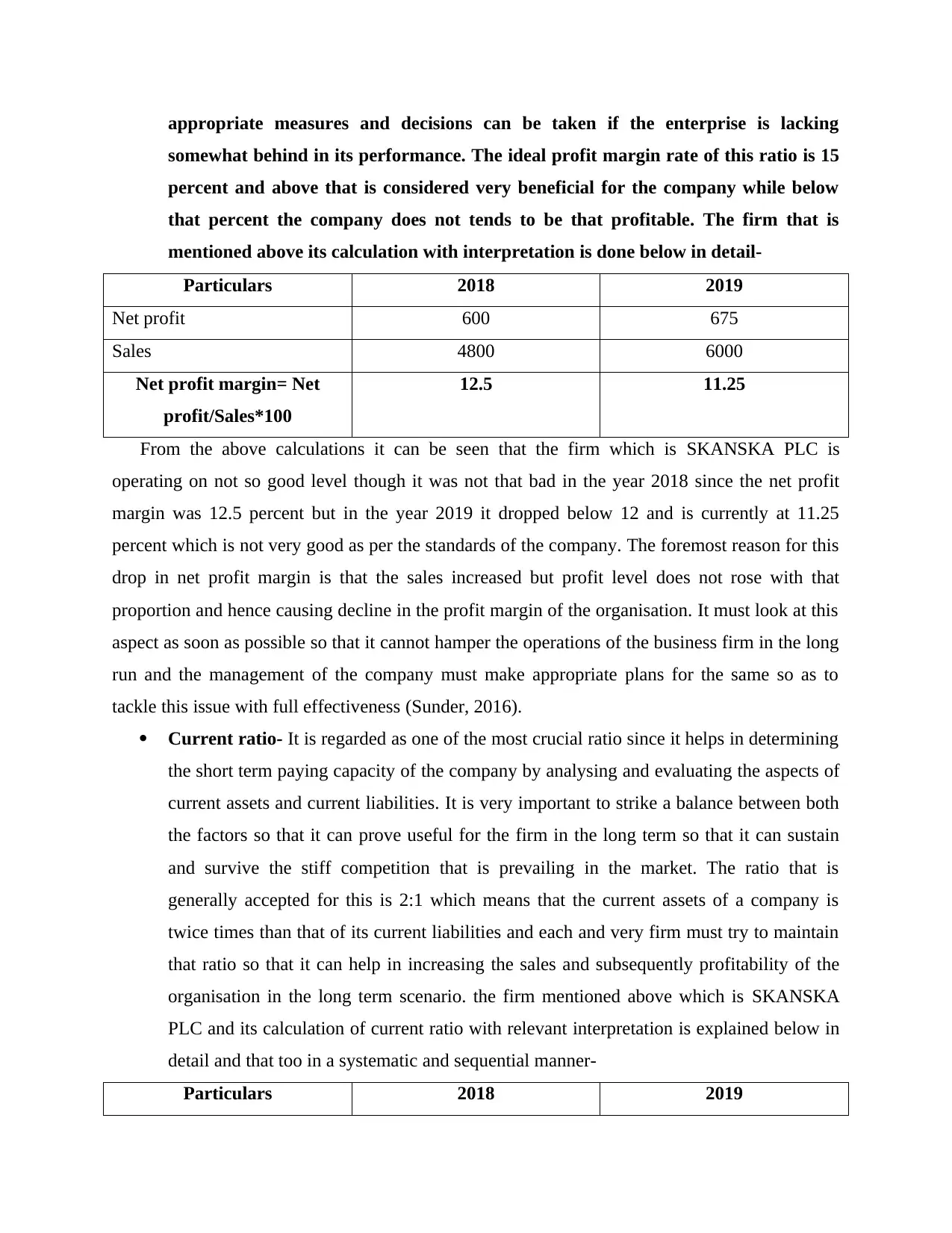
appropriate measures and decisions can be taken if the enterprise is lacking
somewhat behind in its performance. The ideal profit margin rate of this ratio is 15
percent and above that is considered very beneficial for the company while below
that percent the company does not tends to be that profitable. The firm that is
mentioned above its calculation with interpretation is done below in detail-
Particulars 2018 2019
Net profit 600 675
Sales 4800 6000
Net profit margin= Net
profit/Sales*100
12.5 11.25
From the above calculations it can be seen that the firm which is SKANSKA PLC is
operating on not so good level though it was not that bad in the year 2018 since the net profit
margin was 12.5 percent but in the year 2019 it dropped below 12 and is currently at 11.25
percent which is not very good as per the standards of the company. The foremost reason for this
drop in net profit margin is that the sales increased but profit level does not rose with that
proportion and hence causing decline in the profit margin of the organisation. It must look at this
aspect as soon as possible so that it cannot hamper the operations of the business firm in the long
run and the management of the company must make appropriate plans for the same so as to
tackle this issue with full effectiveness (Sunder, 2016).
Current ratio- It is regarded as one of the most crucial ratio since it helps in determining
the short term paying capacity of the company by analysing and evaluating the aspects of
current assets and current liabilities. It is very important to strike a balance between both
the factors so that it can prove useful for the firm in the long term so that it can sustain
and survive the stiff competition that is prevailing in the market. The ratio that is
generally accepted for this is 2:1 which means that the current assets of a company is
twice times than that of its current liabilities and each and very firm must try to maintain
that ratio so that it can help in increasing the sales and subsequently profitability of the
organisation in the long term scenario. the firm mentioned above which is SKANSKA
PLC and its calculation of current ratio with relevant interpretation is explained below in
detail and that too in a systematic and sequential manner-
Particulars 2018 2019
somewhat behind in its performance. The ideal profit margin rate of this ratio is 15
percent and above that is considered very beneficial for the company while below
that percent the company does not tends to be that profitable. The firm that is
mentioned above its calculation with interpretation is done below in detail-
Particulars 2018 2019
Net profit 600 675
Sales 4800 6000
Net profit margin= Net
profit/Sales*100
12.5 11.25
From the above calculations it can be seen that the firm which is SKANSKA PLC is
operating on not so good level though it was not that bad in the year 2018 since the net profit
margin was 12.5 percent but in the year 2019 it dropped below 12 and is currently at 11.25
percent which is not very good as per the standards of the company. The foremost reason for this
drop in net profit margin is that the sales increased but profit level does not rose with that
proportion and hence causing decline in the profit margin of the organisation. It must look at this
aspect as soon as possible so that it cannot hamper the operations of the business firm in the long
run and the management of the company must make appropriate plans for the same so as to
tackle this issue with full effectiveness (Sunder, 2016).
Current ratio- It is regarded as one of the most crucial ratio since it helps in determining
the short term paying capacity of the company by analysing and evaluating the aspects of
current assets and current liabilities. It is very important to strike a balance between both
the factors so that it can prove useful for the firm in the long term so that it can sustain
and survive the stiff competition that is prevailing in the market. The ratio that is
generally accepted for this is 2:1 which means that the current assets of a company is
twice times than that of its current liabilities and each and very firm must try to maintain
that ratio so that it can help in increasing the sales and subsequently profitability of the
organisation in the long term scenario. the firm mentioned above which is SKANSKA
PLC and its calculation of current ratio with relevant interpretation is explained below in
detail and that too in a systematic and sequential manner-
Particulars 2018 2019
Paraphrase This Document
Need a fresh take? Get an instant paraphrase of this document with our AI Paraphraser
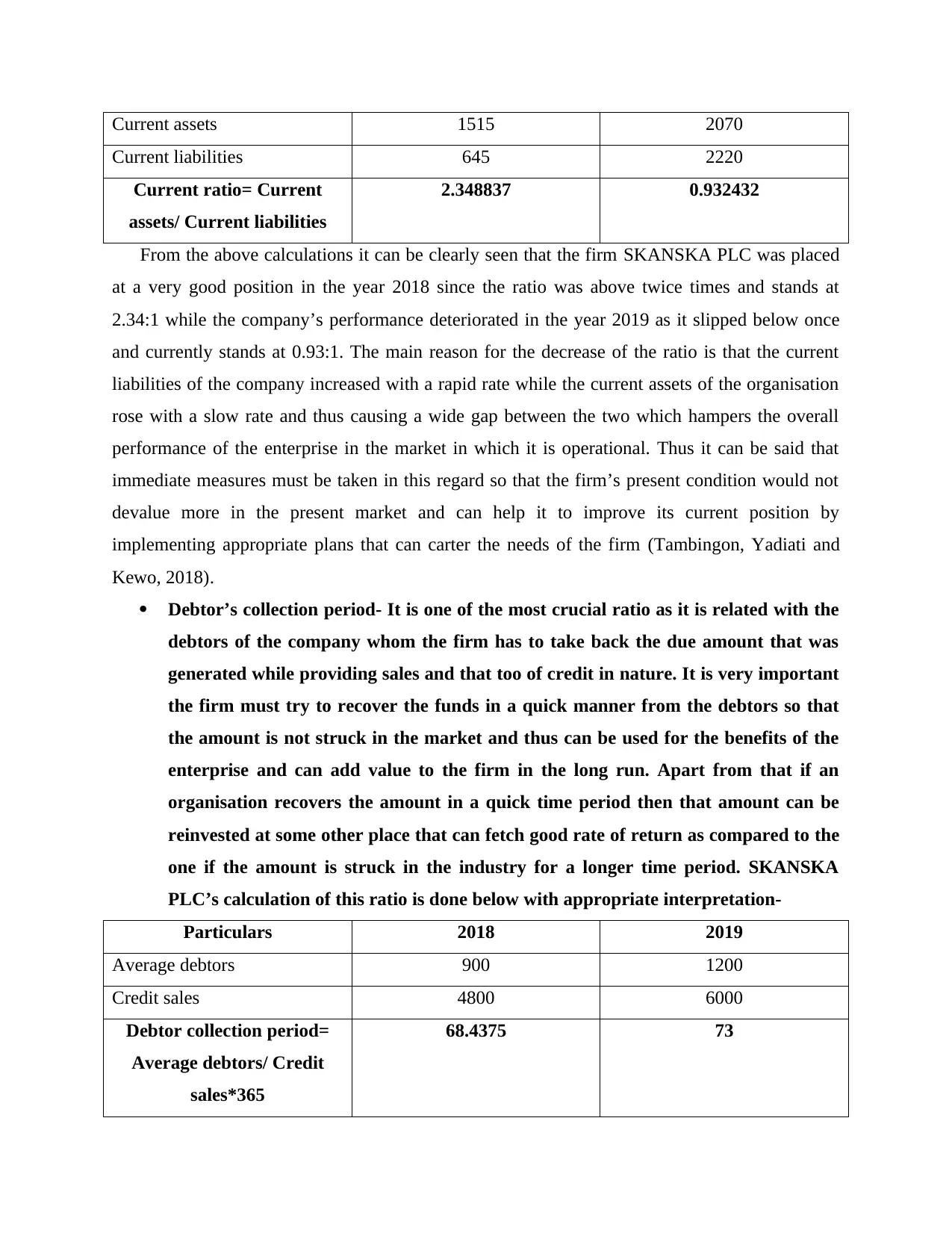
Current assets 1515 2070
Current liabilities 645 2220
Current ratio= Current
assets/ Current liabilities
2.348837 0.932432
From the above calculations it can be clearly seen that the firm SKANSKA PLC was placed
at a very good position in the year 2018 since the ratio was above twice times and stands at
2.34:1 while the company’s performance deteriorated in the year 2019 as it slipped below once
and currently stands at 0.93:1. The main reason for the decrease of the ratio is that the current
liabilities of the company increased with a rapid rate while the current assets of the organisation
rose with a slow rate and thus causing a wide gap between the two which hampers the overall
performance of the enterprise in the market in which it is operational. Thus it can be said that
immediate measures must be taken in this regard so that the firm’s present condition would not
devalue more in the present market and can help it to improve its current position by
implementing appropriate plans that can carter the needs of the firm (Tambingon, Yadiati and
Kewo, 2018).
Debtor’s collection period- It is one of the most crucial ratio as it is related with the
debtors of the company whom the firm has to take back the due amount that was
generated while providing sales and that too of credit in nature. It is very important
the firm must try to recover the funds in a quick manner from the debtors so that
the amount is not struck in the market and thus can be used for the benefits of the
enterprise and can add value to the firm in the long run. Apart from that if an
organisation recovers the amount in a quick time period then that amount can be
reinvested at some other place that can fetch good rate of return as compared to the
one if the amount is struck in the industry for a longer time period. SKANSKA
PLC’s calculation of this ratio is done below with appropriate interpretation-
Particulars 2018 2019
Average debtors 900 1200
Credit sales 4800 6000
Debtor collection period=
Average debtors/ Credit
sales*365
68.4375 73
Current liabilities 645 2220
Current ratio= Current
assets/ Current liabilities
2.348837 0.932432
From the above calculations it can be clearly seen that the firm SKANSKA PLC was placed
at a very good position in the year 2018 since the ratio was above twice times and stands at
2.34:1 while the company’s performance deteriorated in the year 2019 as it slipped below once
and currently stands at 0.93:1. The main reason for the decrease of the ratio is that the current
liabilities of the company increased with a rapid rate while the current assets of the organisation
rose with a slow rate and thus causing a wide gap between the two which hampers the overall
performance of the enterprise in the market in which it is operational. Thus it can be said that
immediate measures must be taken in this regard so that the firm’s present condition would not
devalue more in the present market and can help it to improve its current position by
implementing appropriate plans that can carter the needs of the firm (Tambingon, Yadiati and
Kewo, 2018).
Debtor’s collection period- It is one of the most crucial ratio as it is related with the
debtors of the company whom the firm has to take back the due amount that was
generated while providing sales and that too of credit in nature. It is very important
the firm must try to recover the funds in a quick manner from the debtors so that
the amount is not struck in the market and thus can be used for the benefits of the
enterprise and can add value to the firm in the long run. Apart from that if an
organisation recovers the amount in a quick time period then that amount can be
reinvested at some other place that can fetch good rate of return as compared to the
one if the amount is struck in the industry for a longer time period. SKANSKA
PLC’s calculation of this ratio is done below with appropriate interpretation-
Particulars 2018 2019
Average debtors 900 1200
Credit sales 4800 6000
Debtor collection period=
Average debtors/ Credit
sales*365
68.4375 73
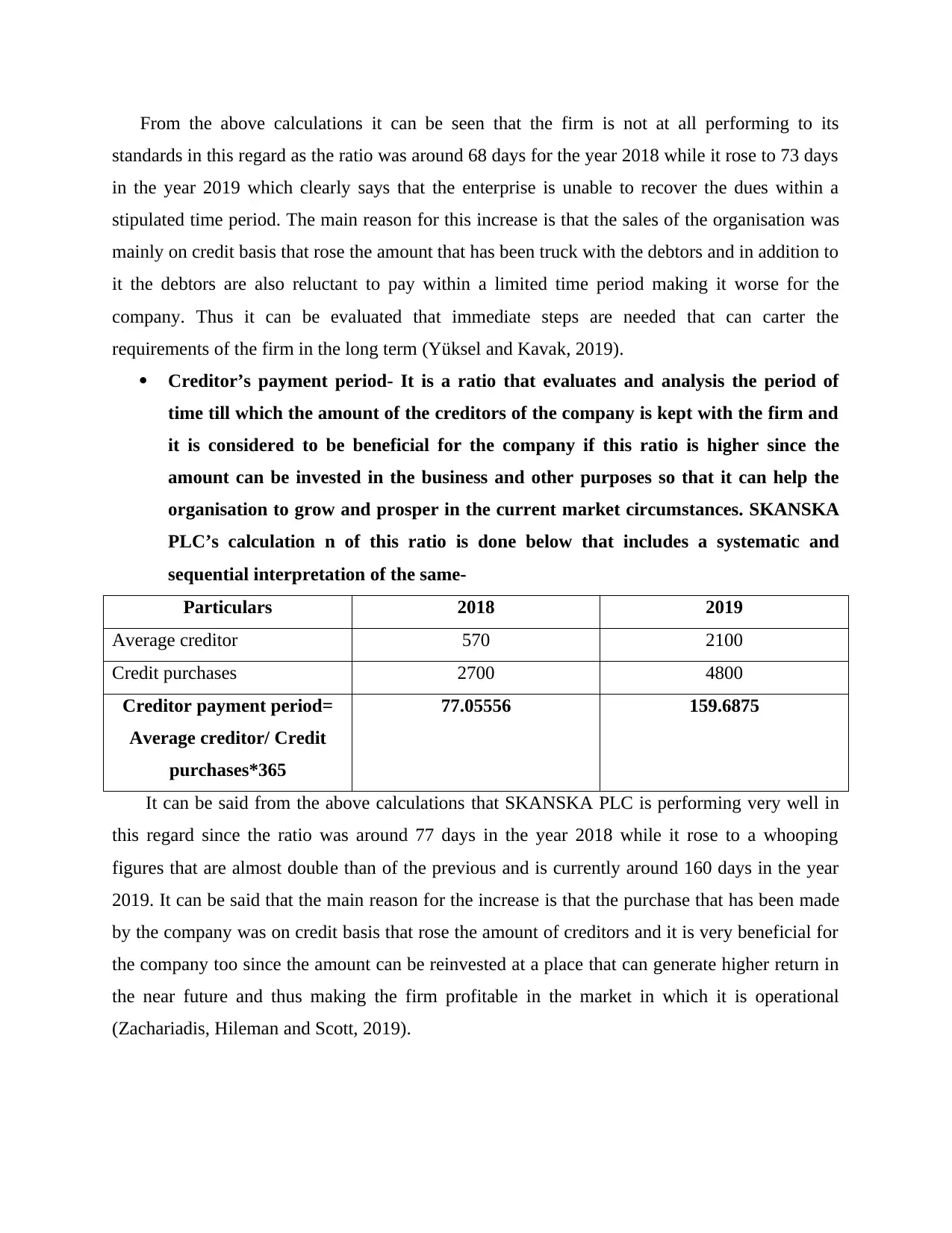
From the above calculations it can be seen that the firm is not at all performing to its
standards in this regard as the ratio was around 68 days for the year 2018 while it rose to 73 days
in the year 2019 which clearly says that the enterprise is unable to recover the dues within a
stipulated time period. The main reason for this increase is that the sales of the organisation was
mainly on credit basis that rose the amount that has been truck with the debtors and in addition to
it the debtors are also reluctant to pay within a limited time period making it worse for the
company. Thus it can be evaluated that immediate steps are needed that can carter the
requirements of the firm in the long term (Yüksel and Kavak, 2019).
Creditor’s payment period- It is a ratio that evaluates and analysis the period of
time till which the amount of the creditors of the company is kept with the firm and
it is considered to be beneficial for the company if this ratio is higher since the
amount can be invested in the business and other purposes so that it can help the
organisation to grow and prosper in the current market circumstances. SKANSKA
PLC’s calculation n of this ratio is done below that includes a systematic and
sequential interpretation of the same-
Particulars 2018 2019
Average creditor 570 2100
Credit purchases 2700 4800
Creditor payment period=
Average creditor/ Credit
purchases*365
77.05556 159.6875
It can be said from the above calculations that SKANSKA PLC is performing very well in
this regard since the ratio was around 77 days in the year 2018 while it rose to a whooping
figures that are almost double than of the previous and is currently around 160 days in the year
2019. It can be said that the main reason for the increase is that the purchase that has been made
by the company was on credit basis that rose the amount of creditors and it is very beneficial for
the company too since the amount can be reinvested at a place that can generate higher return in
the near future and thus making the firm profitable in the market in which it is operational
(Zachariadis, Hileman and Scott, 2019).
standards in this regard as the ratio was around 68 days for the year 2018 while it rose to 73 days
in the year 2019 which clearly says that the enterprise is unable to recover the dues within a
stipulated time period. The main reason for this increase is that the sales of the organisation was
mainly on credit basis that rose the amount that has been truck with the debtors and in addition to
it the debtors are also reluctant to pay within a limited time period making it worse for the
company. Thus it can be evaluated that immediate steps are needed that can carter the
requirements of the firm in the long term (Yüksel and Kavak, 2019).
Creditor’s payment period- It is a ratio that evaluates and analysis the period of
time till which the amount of the creditors of the company is kept with the firm and
it is considered to be beneficial for the company if this ratio is higher since the
amount can be invested in the business and other purposes so that it can help the
organisation to grow and prosper in the current market circumstances. SKANSKA
PLC’s calculation n of this ratio is done below that includes a systematic and
sequential interpretation of the same-
Particulars 2018 2019
Average creditor 570 2100
Credit purchases 2700 4800
Creditor payment period=
Average creditor/ Credit
purchases*365
77.05556 159.6875
It can be said from the above calculations that SKANSKA PLC is performing very well in
this regard since the ratio was around 77 days in the year 2018 while it rose to a whooping
figures that are almost double than of the previous and is currently around 160 days in the year
2019. It can be said that the main reason for the increase is that the purchase that has been made
by the company was on credit basis that rose the amount of creditors and it is very beneficial for
the company too since the amount can be reinvested at a place that can generate higher return in
the near future and thus making the firm profitable in the market in which it is operational
(Zachariadis, Hileman and Scott, 2019).
⊘ This is a preview!⊘
Do you want full access?
Subscribe today to unlock all pages.

Trusted by 1+ million students worldwide

CONCLUSION
From the above it can be concluded that the two factors that are discussed above are very
crucial as well as critical for each and every business firm that is operating in the market and
hence has to be analysed and evaluated with full accuracy. Apart from that it can be concluded
that SKANSKA PLC though have some limitations but still is performing very well in the
market.
From the above it can be concluded that the two factors that are discussed above are very
crucial as well as critical for each and every business firm that is operating in the market and
hence has to be analysed and evaluated with full accuracy. Apart from that it can be concluded
that SKANSKA PLC though have some limitations but still is performing very well in the
market.
Paraphrase This Document
Need a fresh take? Get an instant paraphrase of this document with our AI Paraphraser
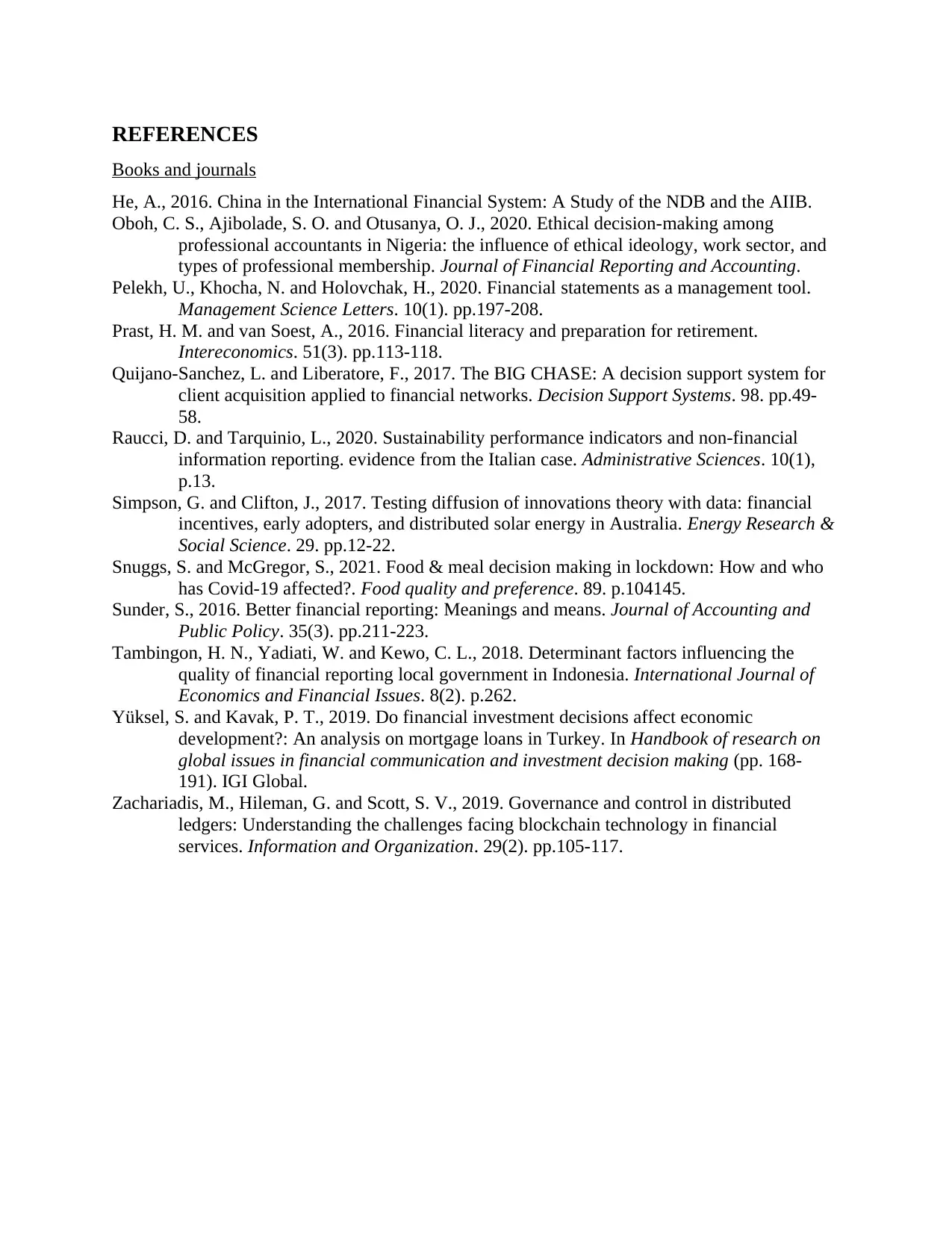
REFERENCES
Books and journals
He, A., 2016. China in the International Financial System: A Study of the NDB and the AIIB.
Oboh, C. S., Ajibolade, S. O. and Otusanya, O. J., 2020. Ethical decision-making among
professional accountants in Nigeria: the influence of ethical ideology, work sector, and
types of professional membership. Journal of Financial Reporting and Accounting.
Pelekh, U., Khocha, N. and Holovchak, H., 2020. Financial statements as a management tool.
Management Science Letters. 10(1). pp.197-208.
Prast, H. M. and van Soest, A., 2016. Financial literacy and preparation for retirement.
Intereconomics. 51(3). pp.113-118.
Quijano-Sanchez, L. and Liberatore, F., 2017. The BIG CHASE: A decision support system for
client acquisition applied to financial networks. Decision Support Systems. 98. pp.49-
58.
Raucci, D. and Tarquinio, L., 2020. Sustainability performance indicators and non-financial
information reporting. evidence from the Italian case. Administrative Sciences. 10(1),
p.13.
Simpson, G. and Clifton, J., 2017. Testing diffusion of innovations theory with data: financial
incentives, early adopters, and distributed solar energy in Australia. Energy Research &
Social Science. 29. pp.12-22.
Snuggs, S. and McGregor, S., 2021. Food & meal decision making in lockdown: How and who
has Covid-19 affected?. Food quality and preference. 89. p.104145.
Sunder, S., 2016. Better financial reporting: Meanings and means. Journal of Accounting and
Public Policy. 35(3). pp.211-223.
Tambingon, H. N., Yadiati, W. and Kewo, C. L., 2018. Determinant factors influencing the
quality of financial reporting local government in Indonesia. International Journal of
Economics and Financial Issues. 8(2). p.262.
Yüksel, S. and Kavak, P. T., 2019. Do financial investment decisions affect economic
development?: An analysis on mortgage loans in Turkey. In Handbook of research on
global issues in financial communication and investment decision making (pp. 168-
191). IGI Global.
Zachariadis, M., Hileman, G. and Scott, S. V., 2019. Governance and control in distributed
ledgers: Understanding the challenges facing blockchain technology in financial
services. Information and Organization. 29(2). pp.105-117.
Books and journals
He, A., 2016. China in the International Financial System: A Study of the NDB and the AIIB.
Oboh, C. S., Ajibolade, S. O. and Otusanya, O. J., 2020. Ethical decision-making among
professional accountants in Nigeria: the influence of ethical ideology, work sector, and
types of professional membership. Journal of Financial Reporting and Accounting.
Pelekh, U., Khocha, N. and Holovchak, H., 2020. Financial statements as a management tool.
Management Science Letters. 10(1). pp.197-208.
Prast, H. M. and van Soest, A., 2016. Financial literacy and preparation for retirement.
Intereconomics. 51(3). pp.113-118.
Quijano-Sanchez, L. and Liberatore, F., 2017. The BIG CHASE: A decision support system for
client acquisition applied to financial networks. Decision Support Systems. 98. pp.49-
58.
Raucci, D. and Tarquinio, L., 2020. Sustainability performance indicators and non-financial
information reporting. evidence from the Italian case. Administrative Sciences. 10(1),
p.13.
Simpson, G. and Clifton, J., 2017. Testing diffusion of innovations theory with data: financial
incentives, early adopters, and distributed solar energy in Australia. Energy Research &
Social Science. 29. pp.12-22.
Snuggs, S. and McGregor, S., 2021. Food & meal decision making in lockdown: How and who
has Covid-19 affected?. Food quality and preference. 89. p.104145.
Sunder, S., 2016. Better financial reporting: Meanings and means. Journal of Accounting and
Public Policy. 35(3). pp.211-223.
Tambingon, H. N., Yadiati, W. and Kewo, C. L., 2018. Determinant factors influencing the
quality of financial reporting local government in Indonesia. International Journal of
Economics and Financial Issues. 8(2). p.262.
Yüksel, S. and Kavak, P. T., 2019. Do financial investment decisions affect economic
development?: An analysis on mortgage loans in Turkey. In Handbook of research on
global issues in financial communication and investment decision making (pp. 168-
191). IGI Global.
Zachariadis, M., Hileman, G. and Scott, S. V., 2019. Governance and control in distributed
ledgers: Understanding the challenges facing blockchain technology in financial
services. Information and Organization. 29(2). pp.105-117.
1 out of 11
Related Documents
Your All-in-One AI-Powered Toolkit for Academic Success.
+13062052269
info@desklib.com
Available 24*7 on WhatsApp / Email
![[object Object]](/_next/static/media/star-bottom.7253800d.svg)
Unlock your academic potential
Copyright © 2020–2025 A2Z Services. All Rights Reserved. Developed and managed by ZUCOL.





